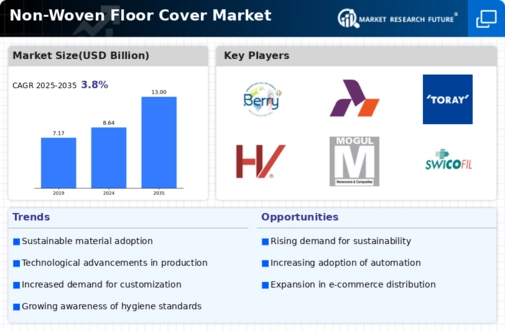Increased Focus on Health and Hygiene
The Global Non-Woven Floor Cover Market Industry sees a heightened focus on health and hygiene, particularly in commercial spaces such as hospitals, schools, and offices. Non-woven floor covers are often designed with antimicrobial properties, making them suitable for environments that require stringent cleanliness standards. This growing awareness of health implications drives demand for flooring solutions that can contribute to a safer indoor environment. As organizations prioritize hygiene, the market for non-woven floor covers is likely to expand, reflecting a broader trend towards health-conscious building materials. The industry's adaptability to these needs positions it favorably in the evolving market landscape.
Rising Demand for Sustainable Materials
The Global Non-Woven Floor Cover Market Industry experiences a notable increase in demand for sustainable flooring solutions. As consumers become more environmentally conscious, manufacturers are responding by developing non-woven floor covers made from recycled and biodegradable materials. This shift aligns with global sustainability goals, potentially driving market growth. For instance, products that utilize eco-friendly fibers are gaining traction, appealing to both residential and commercial sectors. The industry's commitment to sustainability is expected to contribute to the projected market value of 8.64 USD Billion in 2024, reflecting a growing preference for environmentally responsible options.
Technological Advancements in Production
Technological innovations in the production of non-woven floor covers significantly enhance efficiency and product quality. The Global Non-Woven Floor Cover Market Industry benefits from advancements such as automated manufacturing processes and improved bonding techniques. These technologies not only reduce production costs but also allow for the creation of diverse textures and patterns, catering to varying consumer preferences. As a result, manufacturers can offer a wider range of products, which may lead to increased market penetration. The anticipated growth from 8.64 USD Billion in 2024 to 13.0 USD Billion by 2035 indicates the positive impact of these technological advancements on market dynamics.
Diverse Applications Across Various Sectors
The Global Non-Woven Floor Cover Market Industry benefits from its diverse applications across multiple sectors, including residential, commercial, and industrial. Non-woven floor covers are utilized in various settings, from homes to retail spaces and manufacturing facilities. This versatility allows manufacturers to target a wide range of consumers, enhancing market reach. Additionally, the ability to customize non-woven products for specific applications further strengthens their appeal. As the market evolves, the adaptability of non-woven floor covers to meet the unique demands of different sectors is likely to drive growth, contributing to the overall market expansion.
Growth in Construction and Renovation Activities
The Global Non-Woven Floor Cover Market Industry is poised for growth due to the expansion of construction and renovation activities worldwide. As urbanization accelerates, the demand for flooring solutions in residential and commercial buildings rises. Non-woven floor covers, known for their durability and aesthetic appeal, are increasingly favored in new constructions and refurbishments. This trend is particularly evident in emerging markets, where rapid urban development drives the need for innovative flooring solutions. The projected compound annual growth rate of 3.82% from 2025 to 2035 underscores the potential for sustained growth in this sector, fueled by ongoing construction projects.























Leave a Comment